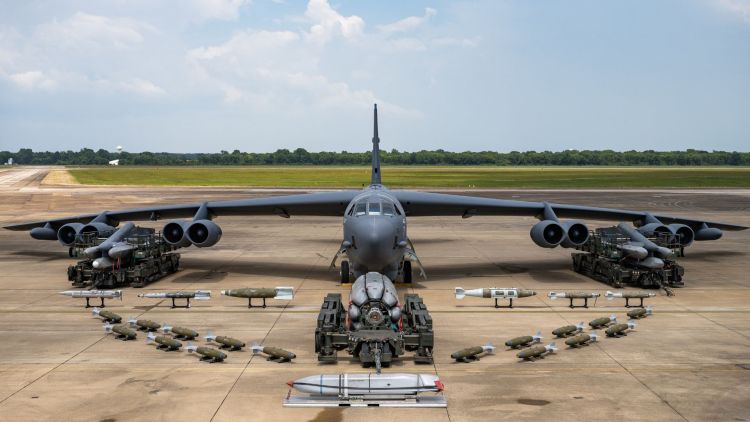The B-52 Stratofortress has been a powerhouse in American airpower since the 1950s, making it one of the longest-serving aircraft in history. And even after all these years, it’s still a key player in both conventional and nuclear missions.
Now, with the B-52J upgrade, initially introduced in 2022, it’s getting its biggest makeover yet.
But, of course, with new engines and advanced radar systems come delays and rising costs, raising questions about whether this investment makes sense in today’s fast-evolving military landscape.
The B-52J upgrade shows just how tricky it is to keep an old warhorse running while adding modern tech.
As the Air Force juggles funding and design challenges, the big question is: Can the B-52J keep up with the future of warfare while staying true to its reliable past?
Let’s delve a little deeper into this matter.
Modernizing a Legend: Why the B-52J is Here to Stay
The Air Force’s decision to upgrade the B-52 instead of retiring it shows just how valuable this strategic bomber still is.
It’s been around since the Vietnam War and continues to play a key role in missions, from carrying nuclear weapons to precision-guided munitions.
And with the goal of keeping it up in the air, flying until the 2050s, the B-52J upgrade ensures this legendary bomber stays relevant and reliable for decades to come.
According to previous reports, the modernization focuses on two big upgrades for the B-52: 1) new Rolls-Royce F130 engines and 2) an advanced radar system.
A view of the lower deck of the B-52 Stratofortress bomber. (Wikimedia Commons)
The engines will boost fuel efficiency by 30 percent, cut down on maintenance, and make the B-52 quieter and stealthier—essential in today’s battlefield.
The radar upgrade, on the other hand, taken from F-15 and F/A-18 systems, will greatly improve targeting, navigation, and electronic warfare.
Combined with other improvements in communication and navigation, these changes aim to make the B-52J upgrade even more effective and ready for the future.
Setbacks and Sticker Shock: What’s Slowing the B-52J Down
While, yes, the B-52J upgrade sounds exciting and promising, it has hit some bumps since its announcement almost two years ago.
Originally expected sooner, the re-engining is now said to have been pushed back to 2033.
Why the delay? Well, according to the Government Accountability Office (GAO) report released last June, the Air Force underestimated the funds needed for the project, leading to setbacks in key design reviews and contract awards.
GAO report (Screenshot)
The radar upgrade has not been smoother, either.
The cost jumped by 12.6 percent, and technical issues like communication problems between processors have caused delays. This alone has raised concerns about whether the radar system will be ready without more costly setbacks.
“Specifically, as the B-52 prototyping effort was extended from preliminary design to critical design, program officials received a proposal for the detailed design work,” the report read. “Program officials stated that the proposal cost exceeded the program’s available funding, and that they asked Boeing to slow its level of work to align with available funding. They also noted that an associated materials contract could not be awarded, causing additional delays.”
The GAO June 2024 report has pointed out that starting production before fully testing everything could lead to expensive reworks if something goes awry.
“Program officials noted that this feedback led to design changes, such as a redesign of service panel hinges to improve maintainer access,” the report read.
Despite its support for this strategy, GAO stated that “the program does not plan to conduct integrated, systems-level testing in an operational environment prior to production, which could provide additional knowledge into how key systems will perform and reduce production risk.”
It’s a risky move that adds more uncertainty to the B-52J’s future.
GAO report (Screenshot)
Staying Relevant in Modern Warfare
Even with the delays, the B-52J is still a key player because of how versatile it is. This bomber can handle everything from gravity bombs to hypersonic missiles, making it effective in a wide range of missions—both regular and nuclear.
As new military tech emerges, the B-52’s adaptability keeps it in the game, allowing it to stay relevant as the Air Force rolls out new platforms to face modern threats.
Looking ahead, nevertheless, the B-52J could even act as a “flying mothership” for drone swarms.
Its long range and massive payload capacity make it perfect for launching and controlling drones, blending old-school reliability with cutting-edge tech.
This potential role reinforces the B-52’s future as a vital part of modern warfare.
Will It Be Really Worth It, Though?
With delays and rising costs, some are starting to wonder if pouring billions into the B-52J is really the smartest move.
Especially NOW, with drones and hypersonic weapons taking center stage, it feels like newer, more advanced tech might be a better investment.
The fact that the Air Force is pushing to modernize a decades-old bomber while retiring newer jets like the F-22 has definitely raised some eyebrows.
B-52 Stratofortress (DVIDS)
But supporters and enthusiasts of the B-52J argue it’s still a solid bet as this bomber has been a workhorse for years, handling everything from strategic bombing to missile launches.
Plus, it’s been a great testbed for new tech.
The upgrades will just make it even more capable, helping it stay relevant for years to come. And when you factor in its long service life and relatively low maintenance costs, it actually starts to look like a pretty cost-effective option.
Where Does the B-52J Go From Here?
For the B-52J upgrade to really take off, the Air Force has some big hurdles to clear—like ironing out the delays and dealing with technical issues.
This means locking down enough funding, making sure testing is thorough, and keeping production on schedule to avoid more setbacks.
Sure, the program has hit some bumps, but with the right approach, these challenges are definitely fixable.
The B-52J’s revamp isn’t just about keeping an old bomber in the sky—it plays a key role in the bigger picture of Uncle Sam’s overall defense strategy.
As threats evolve, having a flexible, multi-purpose aircraft like the B-52 is crucial.
Whether it’s launching long-range strikes or acting as a drone mothership, this upgraded bomber is set to stay a vital part of future military operations.
Wrapping Up…
The B-52J modernization is sort of all about finding that sweet spot between keeping a legendary aircraft flying and making sure it’s ready for the battles of tomorrow.
Sure, there’ve been delays and budget hiccups, but let’s not forget how crucial this bomber is.
With the right funding and management, the B-52J could stick around as a major player in American airpower for years, adapting to whatever challenges come next and solidifying its place in military history.
—
Disclaimer: SOFREP utilizes AI for image generation and article research. Occasionally, it’s like handing a chimpanzee the keys to your liquor cabinet. It’s not always perfect and if a mistake is made, we own up to it full stop. In a world where information comes at us in tidal waves, it is an important tool that helps us sift through the brass for live rounds.



